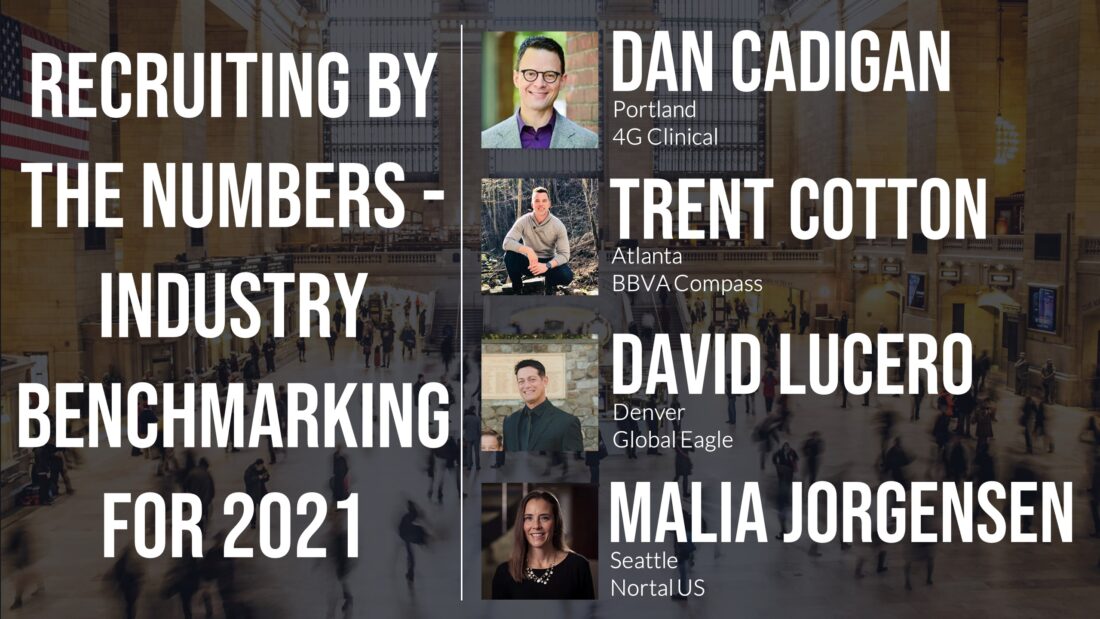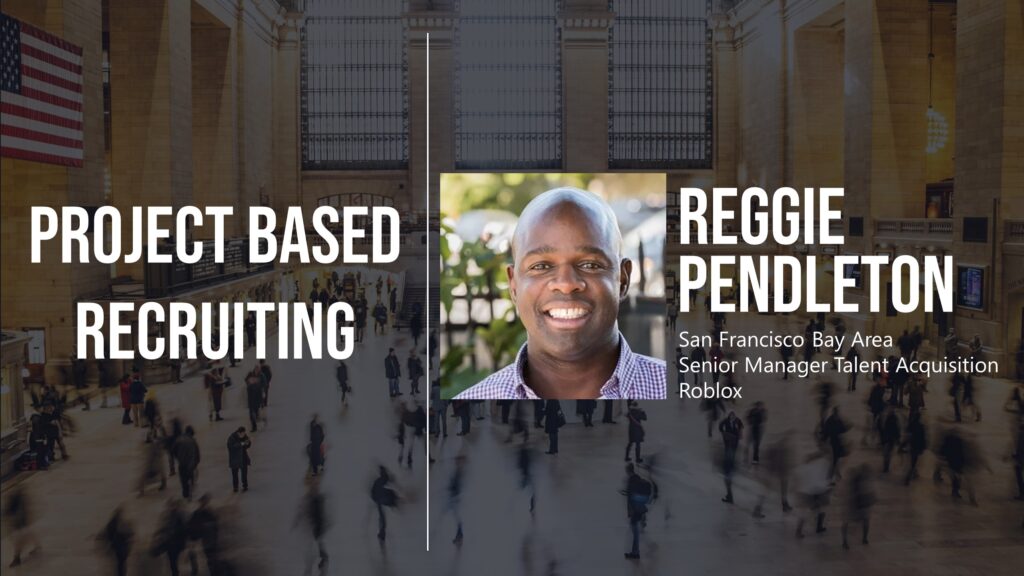We are starting to define a standard, industry recruiting benchmark report that all companies can work to get to so we can have apples to apples conversations around recruiting metrics.
Listen in on what our panelists have to say and chat message with the other audience members.
This event is part of the “Let’s Talk Recruiting” series where a panel of recruiting practitioners get together online and have a conversation on a variety of topics related to corporate recruiting.
Click to Play the Recording
Our Panelists…
| Name & LinkedIn Profile | Group | Title | Company |
Looking for automated reference checking?
Be sure to check out our group sponsor.

We asked our attendees, “What is one thing that you do that get’s the most out of LinkedIn for you?”
Here are their answers:
Chat Messages from the Session…
10:04:34 >> From Sean Rehder : Feel free to add any comments or questions here in the Chat area.
Make sure as an attendee, if you message something in the Chat area that you select “All Panelists and Attendees.”
The default is just to Panelists but I want everyone to see the messages coming through.
10:09:06 >> From Jan Zizzo : how many hires do you hire a year
10:10:10 >> From David Lucero to All panelists : At Global Eagle -would estimate that we are hiring about 200 roles on an annual basis
10:10:23 >> From David Lucero : At Global Eagle -would estimate that we are hiring about 200 roles on an annual basis
10:11:10 >> From Mona Dhillon to All panelists : Dan- What is your ATS- system ?
10:12:58 >> From Natalie Nowak : Are you all tracking time to fill open positions? And are you planning on a typical vacancy period post resignation on a backfill? If so, what’s the typical period?
10:13:34 >> From Justin Rowland to All panelists : Sean, what % would you say is avg for unviewed candidates and obviously 0 is the goal but what would be a good benchmark?
10:14:13 >> From Daniella McDonald : In my last company we had a high unreviewed number because hiring managers didn’t know they had candidates to review. So we set up email notifications in iCIMS so the hiring managers would get emails when they had new candidates which helped cut that number down.
10:14:21 >> From Jonelle Wilson : Wouldn’t you be able to limit the amount of new candidates coming in if you put parameters on how long you have a position posted? i.e. open and post for 1 week, close to review. Repost if necessary, keep close if have acceptable amount of candidates you’re interested in
10:14:37 >> From Malia Jorgensen : My company (Nortal) hired 201 last year – globally
10:15:26 >> From Sean Rehder : for senior level positions or hard to fill roles, the goal should be under 10% un-reviewed rate. Low rates equal faster times to hire also it seems.
10:15:39 >> From Freddie Martins to All panelists : Sorry all for not turning my camera on but something happened to it last week and I’m waiting for a new laptop from IT
10:16:21 >> From Justin Rowland to All panelists : We keep posted keep until offer accepted, which from the start of 2nd rd interviews to that point, they can pile up but we would rather capture them for cross submission, ATS sourcing, etc.
10:17:04 >> From Malia Jorgensen : We also keep them posted until offer is accepted. We then pivot any interesting candidates to other openings.
10:17:23 >> From Justin Rowland to All panelists : Ok, keeping myself honest, I am currently at 34%, mostly IC’s and just closed 3 reqs where all were viewed, so actually would’ve been lower 2 days ago.
10:18:13 >> From Jonelle Wilson : Sean, where are you getting that 10% number?
10:18:21 >> From David Lucero : Natalie – our org does in fact track “time in role” post hire – key to know that our efforts are paying off – but also key to understand so many other variables that impact the person “Staying” – i.e. onboarding, work being done vs. what was recruited for – etc.
10:18:25 >> From Daniella McDonald : Agreed @Malia. At my last company they even liked to keep some jobs open until the candidates showed up to their first day.
10:19:27 >> From Jonelle Wilson : @David yes, those need to be measured to determine quality of hire
10:19:40 >> From Marie deGroh to All panelists : If Recruiters are not able to keep up with reviewing new applicants on their reqs, they may have too large of a req load or they don’t manage time as well as they should. In my recent roles which haven been with F500 companies, we haven’t measured from time of vacancy, just from time posted. We have also put reqs on hold to push the breaks a bit, and repost if needed. I love the time in role metric @David!
10:19:49 >> From Malia Jorgensen : @Daniella I can see the benefits of that as long as you are transparent with candidates about the viability of the opening. We have a lot of repeated roles so we can easily pivot people
10:19:49 >> From David Lucero : We do not fully close out our requisitions until the person’s background and other screening requirements have been completed.
10:19:51 >> From Freddie Martins to All panelists : I totally agree with you on that Dan
10:20:01 >> From Jonelle Wilson : and to understand what goes into increasing the quality of hire
10:20:16 >> From Freddie Martins to All panelists : We do the same here at Signify David
10:20:18 >> From Natalie Nowak : Thanks David!
10:20:20 >> From Sean Hanna : Does anyone look at reviewing performance around quality of hire? Either actual perf rating or collecting feedback from manager 6 months or 12 months in?
10:20:52 >> From Justin Rowland to All panelists : What is the exact formula for cost per interview?
10:21:14 >> From Jonelle Wilson : @David Why is that – is it a system limitation or intentional due to “fall off” after acceptance?
10:22:13 >> From Malia Jorgensen : @Sean we helped HR add some questions around quality of hire to their manager survey which goes out in several stages after a new hire starts.
10:23:58 >> From Natalie Nowak : And are harder to fill positions weighted with “more” points? Do hiring managers understand that as a concept?
10:24:05 >> From David Lucero : @Jonelle – it is intentional due to washout/people. This has not been so much of an issue nowadays with the impact to covid.
10:24:21 >> From Mona Dhillon to All panelists : Yup – we also do promote rate (only at 1 yr mark)
10:24:45 >> From David Lucero : @Natalie – YES- our “Time to Fill Metrics” change based on type of role…i.e. Executive search.
10:25:58 >> From Jonelle Wilson : Yep NPS
10:26:01 >> From Marie deGroh to All panelists : I was an Agile Recruiting Scrum Master at my last company. It worked so well to have a daily stand-up, a dedicated Headcount Owner from the business and a team of Recruiters and Sourcers focusing on filling a set number of ranked roles in a set sprint time. It’s great when you have the buy-in from the business!
10:26:35 >> From Jonelle Wilson : @Trent Do you happen to have an agency background?
10:27:18 >> From Jan Zizzo : Question for Trent: Do you survey the candidates you do not select?
10:27:30 >> From Sean Hanna : How are folks measuring Diversity outside gender, specifically when measuring race/ethnicity outside the US?
10:28:00 >> From Catherine Hansen : @Panelists, what are the inputs into “cost per hire”?
10:28:36 >> From Peter Garneau : I love this metric!
10:29:36 >> From Audrey Fong to All panelists : Trent – Do you use Jira for your ATS?
10:29:54 >> From Mona Dhillon : Does anyone use Geckoboard for recruiting metrics
10:30:08 >> From Peter Garneau : @trent – would love to pick your brain more about quits within 90 days and whose decision was it to hire them.
10:30:56 >> From Peter Garneau : Interested in seeing Hiring Manager Surveys about recruitment support that others may be using.
10:31:08 >> From Freddie Martins to All panelists : Trent – are hiring managers required to fill out the survey and if so, how do you hold them accountable to do so
10:32:34 >> From David Lucero : @Catherine. Cost Per hire = Total international + external Recruiting costs/Total # of hires in a given time frame OR per requisition/role being hired for
10:38:43 >> From Jonelle Wilson : Yep! I created an algorithm to illustrate the cost of someone not being in the role that we need someone in
10:39:06 >> From Jonelle Wilson : It costs us X each day we don’t have someone in that role
10:41:10 >> From Jonelle Wilson : Absolutely – AWS Cloud Eng versus a helpdesk resource is going to vary
10:41:16 >> From Jonelle Wilson : It’s not just “IT”
10:41:33 >> From Sean Hanna : Curious if anyone Is bringing in external benchmarks? Right now we are leveraging LinkedIn Talent Insights for Gender diversity of the talent pool and some publicly available tech benchmarks on gender/race
10:41:33 >> From Freddie Martins to All panelists : David – we also der the type of role and the difficulty of the role when looking at TTF
10:42:42 >> From Jonelle Wilson : Do you utilize the supply and demand functions of the tools you use (LI/ CareerBuilder/ etc.)? In order to drive those conversations around time to fill and costs for recruiting?
10:43:38 >> From Catherine Hansen : @Jonelle / panel – what are inputs for measuring cost for NOT having talent in the role?
10:43:46 >> From Trent Cotton : @jonelle we do use those types of tools but we leverage our sourcing tool Hiretual which provides insights for particular jobs
10:44:12 >> From Trent Cotton : We usually provide this during intakes on the non high volume roles
10:45:54 >> From Roseanne Donohue to All panelists : yes we measure candidate cycle time: apply to offer accept
10:46:05 >> From Peter Garneau : We look at HIRING SPEED. Date of apply on-line to accepted offer. In essence, how long it takes for a candidate to get hired in our organization.
10:46:16 >> From Jonelle Wilson : @Catherine it’s somewhat inexact because you’re looking at overall loss of production, how much the people you’re putting the extra work on in the group and cost of absenteeism due to overworking
10:47:02 >> From Catherine Hansen : @Jonelle – ya that sounds tough. Sounds like those numbers would come from other teams
10:48:04 >> From Steven Green : For those that have a separate sourcing team working in-front of recruiters (to expedite pipelining), do you track sourcing team “assists” to the recruiting team?
10:48:07 >> From Paolo Encarnacion to All panelists : What is your benchmark of a healthy pipeline source e.g. referrals vs application vs passive candidates?
10:48:36 >> From Steven Green : Do you track employee referrals as a dashboard item?
10:49:12 >> From Daniella McDonald : In my last position our learning and development team sent new hire surveys at 30 days and 90 days. The 30 day one did include questions about their recruiting and interview process.
10:49:29 >> From Jonelle Wilson : @Catherine Yes, it’s not an easy figure to gather and HRIS information is needed, along with information from PMs that have resources on the team that you’re working with to get their hours expended on projects and external data on cost of absenteeism
10:52:27 >> From David Lucero : @Paolo – that’s a tough one as you also should be considering the type of position. We are measuring # of viable candidates for our pipeline requisitions for high turn roles (AP/AR, HelpDesk, etc.).
10:52:35 >> From Roseanne Donohue : we do a new hire survey after 30 days online
10:53:30 >> From Roseanne Donohue : we do HR check in calls with new hires after 2 weeks, 30 days and 90 days
10:54:52 >> From Yvette Kamperin to All panelists : What ATS are the panelists using?
10:57:59 >> From Jonelle Wilson : The quality of hire is an important metric as well because if you increase the quality of hire, you can potentially drop the amount of people you hire per year due to lower attrition. If you lower your hires by 5 of candidates with an average salary of 100k = 1/2M savings to the company just in salaries
10:59:36 >> From Sean Hanna : Thanks all for the great convo, have to jump for another call!
10:59:52 >> From Jonelle Wilson : We do in Healthcare – we have residency programs and “winter plans” based on metrics that we see and we utilize external data as well. i.e. we looked at Australia’s numbers since they just came out of winter to see what their flu numbers were this year to plan for our hiring here
10:59:56 >> From Steven Green : Sean, good point on tracking req types. Especially for volume positions of similar types, reasons why backfill rate is higher in some departments vs. others. Finesse’ to examine reasons why vs. put managers on defensive must be practiced to get ‘buy-in’ on teamwork.
11:00:00 >> From Daniella McDonald : Thank you to everyone. I have another call to jump to.
11:00:24 >> From Jonelle Wilson : @Trent so do we
11:00:40 >> From Jonelle Wilson : Yep – their flight risk
11:00:43 >> From David Lucero : Global Eagle ATS is currently Taleo, but looking to move to Oracle Cloud Recruiting
11:00:48 >> From Paolo Encarnacion to All panelists : I’ve worked with different size organizations (20k vs 1k vs 200) employees. For smaller organizations e.g. 200, what would you consider are most critical numbers to be looked at?
11:01:03 >> From Jonelle Wilson : Visier
11:03:26 >> From Mona Dhillon : You are all great thank you for sharing +++
11:04:01 >> From Audrey Fong to All panelists : Thank you!
Some of the attendees…
| Name & LinkedIn Profile | Group | Title | Company |



